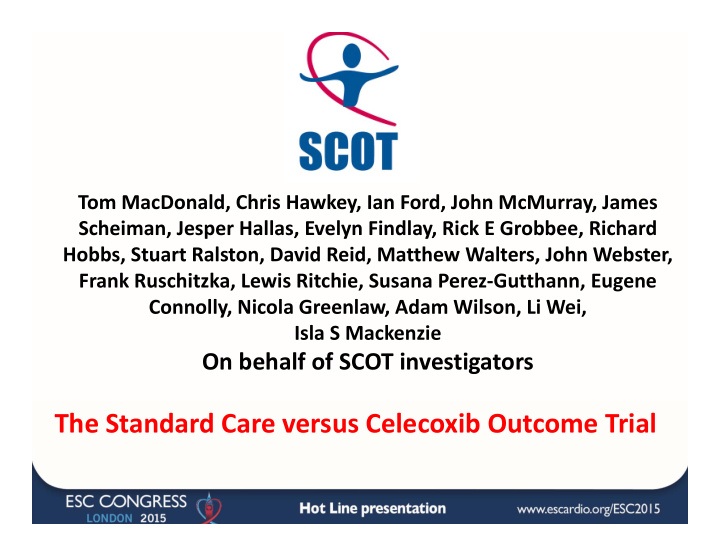



Tom MacDonald, Chris Hawkey, Ian Ford, John McMurray, James Scheiman, Jesper Hallas, Evelyn Findlay, Rick E Grobbee, Richard Hobbs, Stuart Ralston, David Reid, Matthew Walters, John Webster, Frank Ruschitzka, Lewis Ritchie, Susana Perez‐Gutthann, Eugene Connolly, Nicola Greenlaw, Adam Wilson, Li Wei, Isla S Mackenzie On behalf of SCOT investigators The Standard Care versus Celecoxib Outcome Trial
Declarations of interest University of Dundee was the study sponsor. Funding was an investigator initiated research grant from Pfizer. TMM has provided consultancy on NSAIDs to Novartis, Pfizer, NiCox & Astra Zeneca
Background • Selective cyclooxygenase‐2 inhibitors (COX‐2) and non‐selective non‐steroidal anti‐ inflammatory drugs (nsNSAIDs) have been associated with adverse cardiovascular effects. • SCOT compared the cardiovascular safety of celecoxib with nsNSAID therapy in the setting of European healthcare systems. • SCOT was initially an EMA commitment.
Method: Patients • Aged ≥ 60 years with osteoarthritis or rheumatoid arthritis • Free from established cardiovascular disease • Taking chronic prescribed nsNSAIDs in primary care BMJ Open 2013 ;3: e002295
Pragmatic Trial • Search Primary Care Practices • Invite all suitable subjects • Randomise eligible • GPs prescribed treatment • Usual care thereafter • Follow up by Record‐Linkage – Hospitalisations & Deaths BMJ Open 2013 ;3: e002295
End Points • Primary – Hospitalisation for non‐fatal MI, non‐fatal stroke or cardiovascular death • Main Secondary – Hospitalisation or death from ulcer related upper gastrointestinal complications (bleeding, perforation or obstruction) • Other Secondary – Heart failure, mortality, renal failure, critical limb ischaemia; pulmonary embolism.
Power • Powered for non‐inferiority to exclude 40% increase in CV events with celecoxib v nsNSAIDs • Required 277 events on treatment
End Point Detection & Adjudication • By Record‐Linkage to computerised hospitalisation data & deaths and/or Reported by investigators • Original hospital & GP case records retrieved copied & abstracted • Independent end point committees
Committees • Cardiovascular Endpoint Committee: – John McMurray (Chair), Pardeep Jhund, Mark Petrie, Michael MacDonald. • Gastrointestinal Endpoint Committee: – James Scheiman (Chair), John Dillon, Jane Moeller, Angel Lanas. • Independent Data Monitoring Committee: – Kim Fox (Chair), Gordon Murray, Frank Murray.
Results • >9,400 patients screened • 7,297 patients randomised • Mean FU ~ 3.2 years (max 6.3) • 9 regional centers • 706 primary care practices • UK, Denmark & The Netherlands BMJ Open 2013 ;3: e002295
Baseline Characteristics Celecoxib nsNSAIDs Age 68.8y 68.2y % Male 41.9% 39.2% BMI 29.2% 29.8% Current smoker 15.0% 16.0% Diabetes 8.3% 7.8% High BP 44.8% 44.0% High Cholesterol 34.8% 33.2% Statin Rx 21.1% 20.5% Aspirin Rx 11.5% 11.9% Ulcer Healing Rx 38.4% 37.2% Peptic Ulcer History 7.0% 6.5% Diclofenac 38.7% 38.7% Ibuprofen 31.5% 31.6%
Adjudicated event Rates • On treatment primary event rate: – 0.9 per 100 patient years • Intention to Treat primary event rate: – 1.1 per 100 patient years • On treatment Ulcer‐related UGI Complications – 12 events • ITT Ulcer‐related UGI Complications – 15 events
Primary Composite End Point ‐ On Treatment
Primary Composite Endpoint ‐ Intention to Treat
All‐Cause Mortality ‐ On Treatment
All‐Cause Mortality ‐ Intention to Treat
Primary Endpoint by Baseline NSAID Subgroups
50.9% withdrew from celecoxib vs 30.2% from any nsNSAID
% Reasons recorded in those withdrawn from randomised Rx Reason recorded Celecoxib nsNSAID Lack of efficacy 11.2% 3.0% Switch or stopped 6.6% 8.1% Adverse Event 8.3% 4.4% Doctor recommended (non‐AE) 4.7% 6.0% Patient requested 6.0% 2.3% Not tolerated 3.9% 1.2% Serious Adverse Event 2.6% 1.9% Protocol Violation <0.1% <0.1% Other 4.6% 4.4%
Safety Outcomes • Serious Adverse Events: – 1155 (31.7%) celecoxib – 1183 (32.4%) nsNSAID • Serious Adverse Reactions: – 190 (5.2%) celecoxib – 213 (5.8%) nsNSAID • Serious gastrointestinal Adverse Reactions – 38 celecoxib – 66 gastrointestinal nsNSAIDs P<0.007
Safety Outcomes • Adverse Reactions: – 804 (22%) celecoxib – 586 (16.1%) nsNSAIDs (p<0.001)
Summary In patients with arthritis, without known cardiovascular disease, CV event rates were low and serious ulcer‐ related complication rates very low, and neither outcome differed significantly between nsNSAIDs and celecoxib
Implications for patient care • In the study population, nsNSAIDs and celecoxib both appeared acceptably safe. • In patients who get significant symptomatic relief from these medicines the benefit / risk balance appears positive.
Events On Treatment ITT celecoxib nsNSAIDS celecoxib nsNSAIDS MI 38 40 70 56 CVA 16 25 31 36 CV death 15 17 32 39 UGI PUBs 7 5 10 5 CHF 7 10 11 15 Mortality 35 41 99 111 Renal Fail 4 3 7 8
Recommend
More recommend